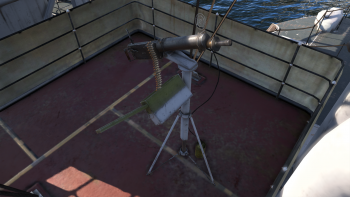MG08 pattern 1908 (7.92 mm)
Contents
Description
Write an introduction to the article in 2-3 small paragraphs. Briefly tell us about the history of the development and combat using the weaponry and also about its features. Compile a list of air, ground, or naval vehicles that feature this weapon system in the game.
Vehicles equipped with this weapon
General info
Tell us about the tactical and technical characteristics of the cannon or machine gun.
Available ammunition
Describe the shells that are available for the weapon and their features and purpose. If it concerns autocannons or machine guns, write about different ammo belts and what is inside (which types of shells).
Comparison with analogues
Give a comparative description of cannons/machine guns that have firepower equal to this weapon.
Usage in battles
Describe the cannon/machine gun in the game - its distinctive features, tactics of usage against notable opponents. Please don't write a "guide" - do not impose a single point of view, but give the reader food for thought.
Pros and cons
Summarise and briefly evaluate the weaponry in terms of its characteristics and combat effectiveness. Mark pros and cons as a list.
Pros:
Cons:
History
The GM08 pattern 1908 is a German variant of the Maxim gun and the standard machine gun for the Heer (Army) during World War I. The German Rifle Commission was already testing the Maxim design in 1899 only three years after it was first used by the British in Africa. The testing at Zorndorf led Ludwig Loewe & Company to get a license for the design from Sir Hiram Stevens Maxim in 1892. Two years later, they got their first orders from the Kaiserliche Marine (Imperial German Navy) for Maxims to use as deck guns and amphibious warfare units. After the founding of the subsidiary company DWM in 1896, the Deutsches Heer experimented with using the Maxim as an artillery weapon to the Jäger (lit: "hunter" used for skirmishers or scouts) in 1898 and again in 1899 at the corps level. The GMG 08 was made by taking the Maxim guns produced by Germany and modifying the design to be more lightweight, introducing a sled mount to improve mobility, an optical sight, and a four-part gun shield protecting the gun operators and the water jacket from enemy fire.
German observations of the 1904-1905 Russo-Japanese War led to the formation of machine gun training for the field-service regiments in 1908 and in 1912 after putting political pressure on the Reichstag (Imperial Diet), the Army Bill was passed which resulted in machine guns being organized with six guns per regiment. The guns served well throughout World War I operated by all three members of the Central Powers. The Germans produced a number of variants including the MG08/15 to fill the light machine gun role and the IMG-08 to arm the aircraft of the Luftstreitkräfte (Air Force). Wartime production was done by both DWM and the state-owned Spandau Arsenal. The MG 08 uses a short-recoil toggle-locked action unlike the long recoil action of the Maxim gun and fired at a rate of 450-500 rounds per minute with 2,200 yards effective range and was water-cooled with a .98 gallon jacket and feed with 250-round fabric belts. A reliable and effective design, the MG 08 was modified with multiple types of sights including a periscope for indirect fire. The Germans used these venerable guns to arm their tanks and armored cars. Early in World War I, the Germans developed a new cartridge type that was called the schweres Spitzgeschoß (heavy spitzer bullet) first on aircraft variants before begin used on their ground-based counterparts around 1918. This bullet increased the effective range to 5,140 yards.
After World War I, a number of different MG 08s were captured by France and the Netherlands and also used by Poland, Latvia, Lithuania, and Finland through the Continuation War and by the Republicans during the Spanish Civil War. The design would be produced under license by China as the Type 24 and it would be used in the Vietnam War. Germany would keep some of MG 08s in service during World War II. Well obsolete by this time, the gun was primarily issued to rear-line units and second-rate fortresses while on the frontline service saw the replacement with first the MG34 and later the MG42.
Media
Excellent additions to the article would be video guides, screenshots from the game, and photos.
See also
- Maxim's (7.62 mm) - Soviet Maxim variant.
- Maxim (6.5 mm) - Japanese Maxim variant.
External links
Paste links to sources and external resources, such as:
- topic on the official game forum;
- other literature.
| Naval machine guns | |
|---|---|
| USA | |
| 7.62 mm | M73 |
| 12.7 mm | AN-M2 |
| Germany | |
| 7.62 mm | MG-3 |
| 7.92 mm | MG08 pattern 1908 · MG15 · MG34 |
| 13.2 mm | Hotchkiss |
| 15 mm | MG M38(t) |
| USSR | |
| 7.62 mm | Maxim |
| 12.7 mm | DShK |
| 14.5 mm | KPV |
| Britain | |
| 7.62 mm | FN MAG |
| 7.7 mm | Lewis 1916 · Vickers GO No.5 |
| 12.7 mm | Vickers Mk.V |
| Japan | |
| 6.5 mm | Maxim · Type 38 pattern 1907 |
| 7.7 mm | Type 89 · Type 92 |
| 13.2 mm | Type 93 |
| Italy | |
| 6.5 mm | Breda Mod.30 · Fiat Model 26 |
| 12.7 mm | Breda-SAFAT |
| 13.2 mm | Breda Model 31 |
| France | |
| 7.7 mm | Darne M1922 |
| 7.92 mm | Hotchkiss pattern 1914 |
| 13.2 mm | Browning · Model 1929 Hotchkiss |




